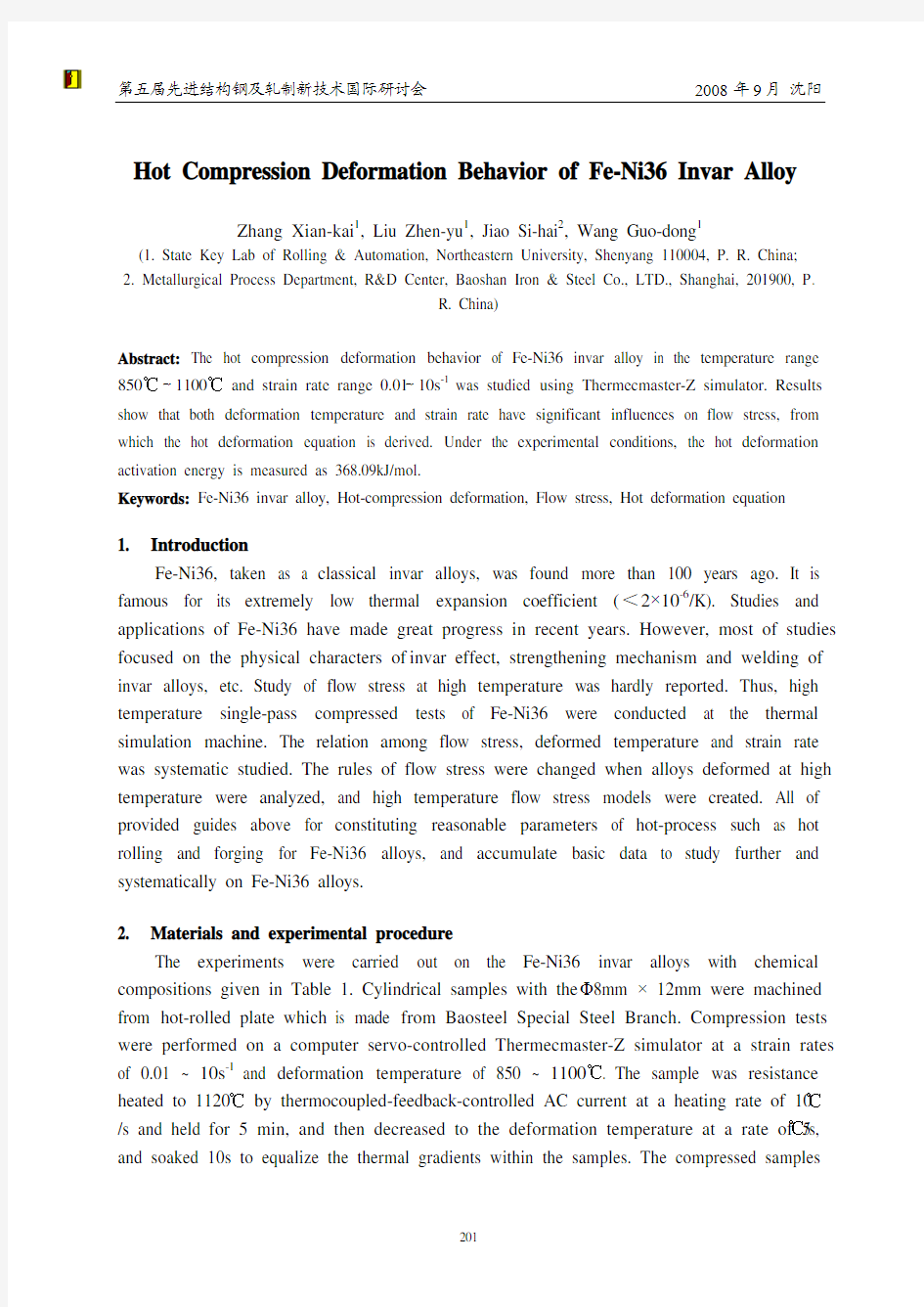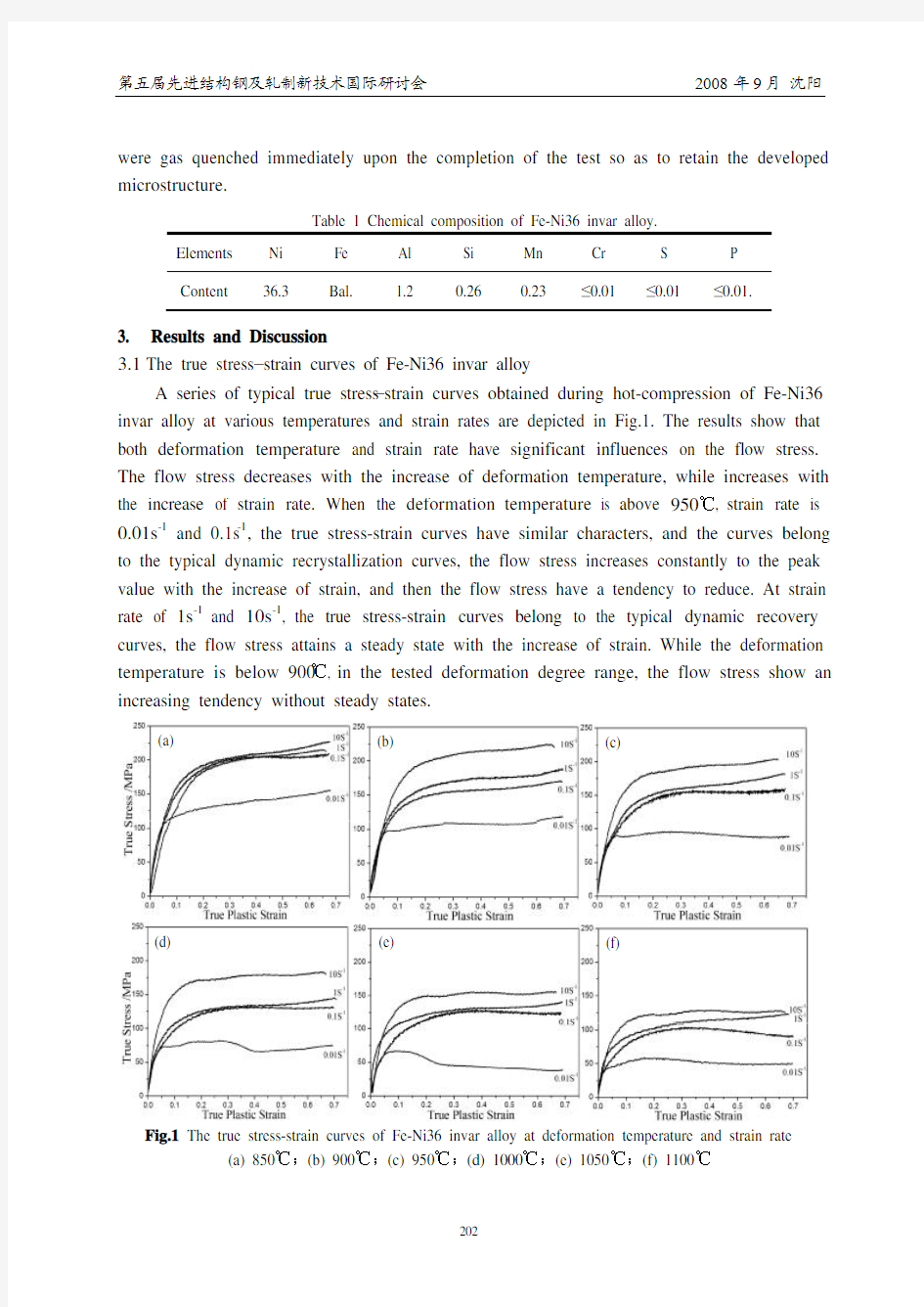Hot Compression Deformation Behavior of Fe-Ni36 Invar Alloy


Hot Compression Deformation Behavior of Fe-Ni36 Invar Alloy
Zhang Xian-kai1, Liu Zhen-yu1, Jiao Si-hai2, Wang Guo-dong1
(1. State Key Lab of Rolling & Automation, Northeastern University, Shenyang 110004, P. R. China;
2. Metallurgical Process Department, R&D Center, Baoshan Iron & Steel Co., LTD., Shanghai, 201900, P.
R. China)
Abstract: The hot compression deformation behavior of Fe-Ni36 invar alloy in the temperature range ℃~10s-1was studied using Thermecmaster-Z simulator. Results 850℃~1100 and strain rate range 0.01
show that both deformation temperature and strain rate have significant influences on flow stress, from which the hot deformation equation is derived. Under the experimental conditions, the hot deformation activation energy is measured as 368.09kJ/mol.
Keywords: Fe-Ni36 invar alloy, Hot-compression deformation, Flow stress, Hot deformation equation
1. Introduction
Fe-Ni36, taken as a classical invar alloys, was found more than 100 years ago. It is famous for its extremely low thermal expansion coefficient (<2×10-6/K). Studies and applications of Fe-Ni36 have made great progress in recent years. However, most of studies focused on the physical characters of invar effect, strengthening mechanism and welding of invar alloys, etc. Study of flow stress at high temperature was hardly reported. Thus, high temperature single-pass compressed tests of Fe-Ni36 were conducted at the thermal simulation machine. The relation among flow stress, deformed temperature and strain rate was systematic studied. The rules of flow stress were changed when alloys deformed at high temperature were analyzed, and high temperature flow stress models were created. All of provided guides above for constituting reasonable parameters of hot-process such as hot rolling and forging for Fe-Ni36 alloys, and accumulate basic data to study further and systematically on Fe-Ni36 alloys.
2. Materials and experimental procedure
The experiments were carried out on the Fe-Ni36 invar alloys with chemical compositions given in Table 1. Cylindrical samples with the Φ8mm × 12mm were machined from hot-rolled plate which is made from Baosteel Special Steel Branch. Compression tests were performed on a computer servo-controlled Thermecmaster-Z simulator at a strain rates of 0.01 ~ 10s-1and deformation temperature of 850 ~ 1100℃. The sample was resistance heated to 1120℃by thermocoupled-feedback-controlled AC current at a heating rate of 10℃/s and held for 5 min, and then decreased to the deformation temperature at a rate of 5℃/s, and soaked 10s to equalize the thermal gradients within the samples. The compressed samples
were gas quenched immediately upon the completion of the test so as to retain the developed microstructure.
Table 1 Chemical composition of Fe-Ni36 invar alloy.
Elements Ni Fe Al Si Mn Cr S P Content
36.3
Bal.
1.2
0.26
0.23
≤0.01
≤0.01
≤0.01.
3. Results and Discussion
3.1 The true stress –strain curves of Fe-Ni36 invar alloy
A series of typical true stress –strain curves obtained during hot-compression of Fe-Ni36 invar alloy at various temperatures and strain rates are depicted in Fig.1. The results show that both deformation temperature and strain rate have significant influences on the flow stress. The flow stress decreases with the increase of deformation temperature, while increases with the increase of strain rate. When the deformation temperature is above 950℃, strain rate is 0.01s -1 and 0.1s -1, the true stress-strain curves have similar characters, and the curves belong to the typical dynamic recrystallization curves, the flow stress increases constantly to the peak value with the increase of strain, and then the flow stress have a tendency to reduce. At strain rate of 1s -1 and 10s -1, the true stress-strain curves belong to the typical dynamic recovery curves, the flow stress attains a steady state with the increase of strain. While the deformation temperature is below 900℃, in the tested deformation degree range, the flow stress show an increasing tendency without steady states.
Fig.1 The true stress-strain curves of Fe-Ni36 invar alloy at deformation temperature and strain rate
(a) 850℃;(b) 900℃;(c) 950℃;(d) 1000℃;(e) 1050℃;(f) 1100℃
(a)
(b)
(c)
(d)
(e) (f)
3.2. Constitutive analysis for Fe-Ni36 invar alloy
It is clear that there is a relationship among flow stress, strain rate, and deformation temperature of the Fe-Ni36 invar alloy. Therefore, it is necessary to understand the plastic deformation behavior of the alloy at high temperature and pave the way for rolling processing.
On the data of different hot working, it is shown that at low stress levels, the relation
between steady state stress σ and strain rate ε
& follows exponential relationship [1,2]: n A σε
1=& (ασ<0.8) (1) where A 1 and n are both constants.
At high stress levels, the relation between steady state stress and strain rate follows power exponential relationship [1,2]:
)exp(2βσε
A =& (ασ>1.2) (2) where A 2 and β are both constants.
These relations describe the dynamic equilibrium of the strain-hardening and dynamic-softening at high temperature deformation, which is similar with the steady creep. According to these similarity, Sellars and Tegart proposed a hyperbolic Arrhenius-tape equation describing the thermal activation steady deformation behavior [3]:
)]/(exp[)][sinh(RT Q A n ?=ασε
& (3) Where A, α and n are all constants. R is the gas constant (8.314 Jmol -1K -1), Q is the
activation energy for deformation, ε
& is the strain rate, and T is the absolute temperature. Here, α, β and n satisfies α = β/n 。
In 1944, Zener and Hollomon proposed a concept of parameter Z. Its physical meaning is temperature compensating deformation rate factor, depending on T , but it has no correlation with Q. It can describe the relation between the strain rate and deformation temperature by Zener-Hollomo parameter Z [4~6]:
n A RT Q Z )][sinh()/exp(ασε
==& (4) Therefore, it is shown that given material parameters β, n, α, A, Q, the flow stress at
different deformation temperature and strain rate can be calculated.
The logarithmic transformation for Eq. (1) and Eq. (2) are: σε
ln ln ln 1n A +=& (5) βσε
+=2ln ln A & (6) According to the linear relationship between ln ln σε
?&and εσ&ln ? (Fig. 2(a, b)), it
can be calculated that the value of n=9.5329325,β=0.0888125,so α =β/n =0.009316。
Fig.2 (a) .ln εas a function of ln σat different temperatures; (b) .
ln ε as a function of steady state
stress σ at different temperatures.
The logarithmic transformation for Eq. (3) is:
.111ln[sinh()]ln ln Q
A n n n RT
ασε=?++? (7)
Then, n and Q can be expressed as: .
ln |ln[sinh()]
T n ε
ασ?=
? (8)
.
ln ln[sinh()]
||ln[sinh()](1)
T Q R
T εεασασ???=??? (9)
To calculate n and Q , the linear relationships between .
ln ε and ln[sinh(ασ )] are shown
in Fig. 3(a) and those of ln[sinh(ασ )] versus 1/T in Fig. 3(b). Then, it can be calculated that n = 7.02955 and Q = 368.09 kJ/mol.
The logarithmic transformation for Eq. (4) is:
ln ln ln[sinh()]Z A n ασ=+ (10)
ε&ln /s -1 ε&ln /s -1 (a ) (b )
Fig.3. (a) .
ln ε as a function of ln[sinh(ασ )] at different temperatures; (b) ln[sinh(ασ )] as a function of reciprocal T at different strain rates.
To calculate A , the linear relationships between lnZ and ln[sinh(ασ )] are shown in Fig. 4.
The intercept is ln A . Then, it can be calculated that A =e 31.0914
.
Fig.4. Relationship between ln[sinh(ασ )] and lnZ of Fe-Ni36 invar alloy.
Substitute material parameters for Eq. (3), (4) .
31.09147.02955368.09
[sinh(0.009316)]exp()e RT
εσ=? .368.09
exp(
Z RT
ε= 4. Conclusions
1. When the deformation temperature is above 950℃, strain rate are 0.01s -1 and 0.1s -1, the true stress-strain curves of the tested Fe-Ni36 invar alloy belong to the typical dynamic recrystallization curves. At strain rate of 1s -1 and 10s -1, the true stress-strain curves belong to
ε
&ln /s -1
the typical dynamic recovery curves. While the deformation temperature is below 900℃, in the tested deformation degree range, the flow stress show an increasing tendency without steady state.
2. The hot deformation activation energy Q of the tested Fe-Ni36 invar alloy is 368.09 kJ/mol and the hot deformation equation is
References
[1] SHENG Z Q, SHIVPURI R. Modeling flow stress of magnesium alloys at elevated temperature [J]. Materials Science and Engineering A, 2006, 419: 202?208.
[2] BARNETT M R. Influence of deformation conditions and texture on the high temperature flow stress of
magnesium AZ31 [J]. J Light Met, 2001, 1(3): 167?177
[3] C.M.Sellars, W.J.Tegart. Physical Metallurgy of Thermo-mechanical Processing of Steels and Other
Metals. Science Review Methods. 1966, (63): 731?735.
[4] SELLARS C M. Hot workability [J]. Int Metallurg Rev, 1972, 17: 1?24.
[5] YU Kun, LI Wen-xian, ZHAO Jun, MA Zheng-qing, WANG Ri-chu. Plastic deformation behaviors of
a Mg-Ce-Zn-Zr alloy [J]. Scripta Materialia, 2003, 48: 1319?1323.
[6] GUO Qiang, YAN Hong-ge, CHEN Zhen-hua, ZHAN Guo-hui. Hot compression deformation behavior
of AZ31 magnesium alloy at elevated temperature [J]. The Chinese Journal of Nonferrous Metals, 2005, 15(6): 900?906. (in Chinese)
31.09147.02955368.09[sinh(0.009316)]exp()
e RT εσ?
=?
